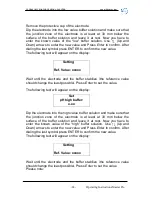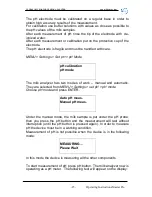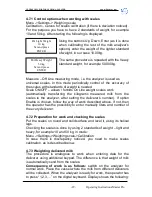
ULTRASONIC PORTABLE MILK ANALYZER
www.milkotester.com
-14-
Operating Instructions Master Pro
corresponding reference method of analyses (Gerber for fat, Kjeldahl
for proteins etc). In order to establish the possible discrepancy and to
correct the readings of the milk analyzer do the following:
Taking samples and preparation of samples for checking the accuracy
of the milk analyzer, making corrections and recalibration
This is a basic moment for the correct checking the accuracy of the
analyzer and for making correct and precise correction and calibration.
It is accomplished according Appendix Taking and preparation of
samples for checking correctness of the milk analyzer, making
corrections and recalibration.
Determination the type of the discrepancy:
Making measurements
Make measurements with different samples (not less than 3) with
known values of a separate parameter (for example fat content),
determined by the known reference methods of analyses (for example
Gerber's method for determination of fat content). For more accuracy it
is recommended among these samples to be also such with values,
close to the lowest and highest bounds for the measured parameters.
Make 5-time measurement for each of the samples. Calculate the
average value for each sample parameter, without taking into
consideration the first measurement for each sample.
Analyzing the measurement results
Make comparison between the values of the parameter from the
reference sample and measured with the analyzer. Make analyses of
the difference received.
If the received differences are relatively constant value for samples
with different content of the analyzed parameter, it is necessary to
make correction.
For example
М
% of the reference samples:
2,20 3,00 3,80 4,60 5,20
М
% average when measuring
with the analyzer:
2,38 3,17 4,01 4,79 5,42
Difference:
0,18 0,17 0,21 0,19 0,22















































